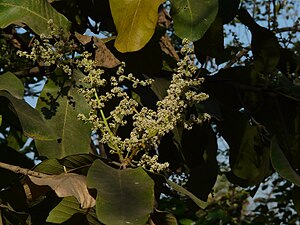Note: This is a project under development. The articles on this wiki are just being initiated and broadly incomplete. You can Help creating new pages.
Buchanania lanzan - Chironji Tree
Buchanania lanzan is an evergreen tree. It grows up to 18 metres tall. The tree is extensively harvested from the wild, and also cultivated for its edible seed, especially in India. It is commonly sold in local markets and has occasionally been exported.
Uses
Parts Used
Chemical Composition
Buchanania lanzan was tested for the presence of Alkaloids, Carbohydrates, Flavonoids, Steroids using different qualitative chemical methods.[2]
Common names
| Language | Common name |
|---|---|
| Kannada | ಚಾರೊಳೆ Charole ಚಾರೊಳಿ Charoli |
| Hindi | Char, Chironji |
| Malayalam | Muungaappeezh |
| Tamil | Charoli |
| Telugu | Charumamidi |
| Marathi | Charoli |
| Gujarathi | Charoli |
| Punjabi | NA |
| Kashmiri | NA |
| Sanskrit | Akhatth |
| English | Chironji Tree, Almondette |
Properties
Reference: Dravya - Substance, Rasa - Taste, Guna - Qualities, Veerya - Potency, Vipaka - Post-digesion effect, Karma - Pharmacological activity, Prabhava - Therepeutics.
Dravya
Rasa
Guna
Veerya
Vipaka
Karma
Prabhava
Habit
Identification
Leaf
| Kind | Shape | Feature |
|---|---|---|
Flower
| Type | Size | Color and composition | Stamen | More information |
|---|---|---|---|---|
| Flowering from February to April |
Fruit
| Type | Size | Mass | Appearance | Seeds | More information |
|---|---|---|---|---|---|
| Fruiting from February to April |
Other features
List of Ayurvedic medicine in which the herb is used
Where to get the saplings
Mode of Propagation
How to plant/cultivate
A plant of mainly drier areas in the tropics and subtropics, where it is found at elevations up to 1,200 metres. It grows best in areas where annual daytime temperatures are within the range 32 - 42°c, but can tolerate 5 - 48°c.[5]
Commonly seen growing in areas
Photo Gallery
References
- ↑ 1.0 1.1 ”Karnataka Medicinal Plants Volume-3” by Dr.M. R. Gurudeva, Page No.1063, Published by Divyachandra Prakashana, #6/7, Kaalika Soudha, Balepete cross, Bengaluru
- ↑ [Chemical constituents]
- ↑ Common names
- ↑ [Morphology]
- ↑ Cultivation
External Links
- Ayurvedic Herbs known to be helpful to treat Diarrhoea
- Ayurvedic Herbs known to be helpful to treat Skin diseases
- Ayurvedic Herbs known to be helpful to treat Coughs
- Ayurvedic Herbs known to be helpful to treat Asthma
- Herbs with Seed used in medicine
- Herbs with Stem bark used in medicine
- Herbs with Leaf used in medicine
- Herbs with Root used in medicine
- Herbs with common name in Kannada
- Herbs with common name in Hindi
- Herbs with common name in Malayalam
- Herbs with common name in Tamil
- Herbs with common name in Telugu
- Herbs with common name in Marathi
- Herbs with common name in Gujarathi
- Herbs with common name in Sanskrit
- Herbs with common name in English
- Habit - Evergreen tree
- Index of Plants which can be propagated by Seed
- Herbs that are commonly seen in the region of Open forests
- Herbs that are commonly seen in the region of Dry forests
- Herbs that are commonly seen in the region of Lowland forests
- Herbs
- Pages without herbs images


